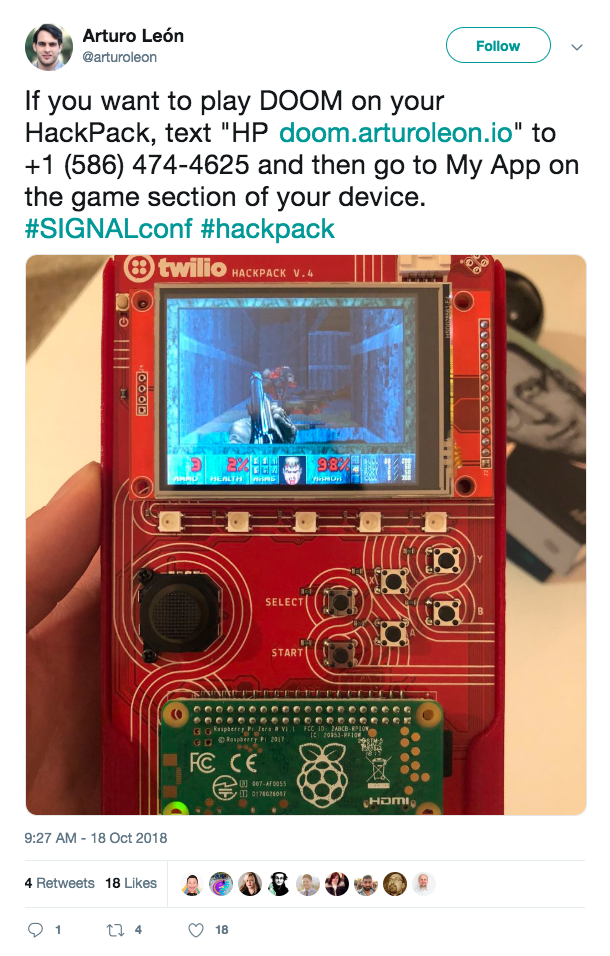Re-Introducing the Hackpack v4: Twilio's Open Source Hardware Badge
Time to read:
This post is part of Twilio’s archive and may contain outdated information. We’re always building something new, so be sure to check out our latest posts for the most up-to-date insights.

Last week at SIGNAL 2018, we debuted v4 of our venerable hardware badge that we lovingly call the Hackpack.
This year’s Hackpack was our most advanced yet. Sporting a joystick, 7 buttons, a touchscreen, a massive battery, and Linux on a Raspberry Pi Zero W, we hoped to craft the perfect badge for both our conference and your next handheld computing project.
We also designed it with a special goal in mind: to release under an open hardware license. That’s why today we’re proud to announce the hardware collateral and assembly instructions are available under the Solderpad 2.0 license.
Go to the hardware repository now.
Building Twilio’s Hardware Badge
We designed and built v4 of the Hackpack using version 5 of KiCad. And even if you never fire up KiCad, you can take the gerbers to your favorite PCB house and (with a fair bit of soldering) produce a working badge.
If you want to take the design further? In our repository, you’ll find board files, schematics, a bill of materials, renders, and the aforementioned pre-exported gerbers.
You’ll also find advanced assembly instructions for some of the trickier parts.
(And yes, the joystick is a bear to solder.)
Making it Work with Twilio’s Firmware and Drivers
In addition to the parts listed in the repository, you’ll also need to find a Raspberry Pi Zero W.
- Use either our Kiosk breakout image or our firmware repository with a vanilla Raspbian installation.
- Burn to a 8GB or larger MicroSD card.
- Once the script runs or the image is burned, the device should Just Work™ with your SD.
- You’ll have our drivers running on your Hackpack ready for your next project.
Note that you can use a Micro USB OTG cable and a micro HDMI breakout to use the Hackpack like a desktop computer. Having the setup at hand eases development and installation.
As a bonus, we even have some games pre-installed with the firmware:

Craft Your Next Project – or Your Own Badge
Hopefully we’ve created an enjoyable base for you to build upon.
We built the Hackpack v4 in the style of a vertical handheld gaming device. It has UART broken out on a Grove Header, one S***** Add-On (SAO) header (i2c), and 5 addressable 65k color LEDs. For more advanced modifications, there are a number of unused channels on our A/D converter for you to add additional inputs. It already has Linux onboard with drivers for the touchscreen, display, buttons, and LEDs.
While we’re thrilled with the Hackpack platform and framework we’re releasing today, we know you’re going to take it to new heights. We’re especially excited to see how you improve the platform, and hope you release your modifications under a permissive license where we might incorporate them in a future design.
We can’t wait for you to get into the hardware, probe it, and test the limits. We’re extremely excited to see how you modify and improve the badge. And, as always, we can’t wait to see what you build.
For more information on the Hackpack and firmware, see our dedicated Hackpack website.
Related Posts
Related Resources
Twilio Docs
From APIs to SDKs to sample apps
API reference documentation, SDKs, helper libraries, quickstarts, and tutorials for your language and platform.
Resource Center
The latest ebooks, industry reports, and webinars
Learn from customer engagement experts to improve your own communication.
Ahoy
Twilio's developer community hub
Best practices, code samples, and inspiration to build communications and digital engagement experiences.


